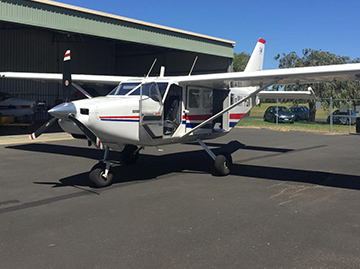- It pays to have a plan if things start to go wrong - in this case the pilot made all the right moves.

On 21 October 2015, a Gippsland Aeronautics GA-8 aircraft was conducting parachute operations at Busselton Airport, Western Australia.
The aircraft took off with a pilot and seven parachutists on board. As it climbed through about 2,000 ft, the pilot observed a decrease in the engine manifold pressure. The fuel flow also increased significantly. As the aircraft was tracking south towards forested terrain, the pilot elected to turn back towards the aerodrome, and continue the climb, in case the engine issue worsened. The pilot conducted the standard engine checks, but the engine continued to produce only partial power. In response the pilot broadcast a Mayday.
The pilot advised the parachutists they would establish the aircraft in the drop run overhead the aerodrome at about 4,000 ft. As the pilot subsequently reduced the power to allow the parachutists to exit the aircraft, the engine ran roughly. Six of the parachutists exited normally and landed safely at the drop zone, while the seventh, who was also a company pilot and seated in the front passenger seat, remained in the aircraft with the pilot in command.
The pilot then increased the aircraft’s power until the engine ran smoothly, although only producing partial power, while continuing the descent to the aerodrome. The pilot also advised Air Traffic Control that they did not require immediate assistance and downgraded to a PAN, as the engine continued to produce some power. The aircraft landed safely at Busselton.
After shutting down the engine, the pilot consulted with the maintainer, and found that the intake tube on the No. 4 cylinder was loose.
A reminder that constant monitoring of the engine instruments can provide early indication of a problem.
This incident highlights the importance of having thoroughly rehearsed emergency procedures, particularly for parachute operations.The parachutists had, in accordance with standard procedures, removed the single point restraints during the climb, and were prepared to exit the aircraft quickly.
For pilots, this provides a reminder that constant monitoring of the engine instruments can provide early indication of a problem. Acting quickly on this information may reduce the impact of partial or total power loss on flight safety.
The ATSB publication Avoidable Accidents No. 3 – Managing partial power loss after take-off in single-engine aircraft, provides information also relevant to partial losses of power in flight as well as after take-off. Following a complete engine failure, a forced landing is inevitable. For a partial power loss, pilots are faced with deciding whether to continue the flight or land immediately.
Read the report: Partial engine failure involving a Gippsland Aeronautics GA-8, VH-FGN, near Busselton Airport, Western Australia, on 21 October 2015


